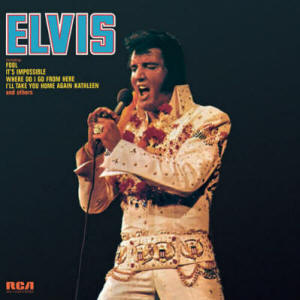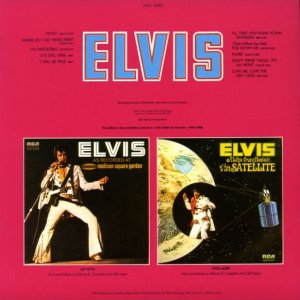

The successor of the sales monster "Aloha
From Hawaii Via Satellite" hit the stores on
July 16, 1973 and was simply called "Elvis". On
the 21st of the month it entered Billboard's
"Top LPs Chart" where it stayed for 13 weeks and
peaked at number 52. On August 25th "Elvis" also
enterted the "Hot Country Album Chart". Here the
200,000 sold units were enough for a run of 14
weeks and an entry in the top 10 (it reached
number 8). In Great Britain the king scored a
top 20 hit with his album, worldwide "Elvis"
sold a million copies. Today that would be 150
million paid streams of the album or 1.5 billion
paid streams of individual tracks. Commercially
this release was on the same level as "Speedway"
(1968) and "Elvis Now" (1972), which means it
was a disaster. Especially because one could
have expected a certain amount of success of the
follow up to a mega seller like "Aloha".
Obviously it still was an event to see Elvis in
concert and maybe the people were also buying an
accordant album as a souvenir, but it spoke
volumes that the king was not able to convince
anybody to buy his new recordings.
In 2016 the complete Presley catalogue was
restored and remastered by Vic Anesini for a
boxed set of 60 compact discs called "The Album
Collection". Sony Music Entertainment provides
the streaming platforms with the same versions
of the individual albums (in this case with
"Separate Ways", "For The Good Times", "Burning
Love", "Always On My Mind", "It's A Matter Of
Time" and "An American Trilogy" as bonus
tracks), albeit in 24 bit/90 khz flac. That
means, if the platform of your choice supports
high resolution audio, you can enjoy the tracks
in the same quality Sony used to scan and master
them. On Spotify, which has a market share of
approximately 30% and is the only platform that
publishes streaming figures, "Elvis" accumulates
738 million streams. So the sales fiasco from
1973 has overtaken stuff like "Elvis As Recorded
At Madison Square Garden" and "Elvis' Golden
Records - Volume 3" and now belongs to the most
popular Presley albums!
RCA Records used a picture taken during the
"Aloha" concert for the cover. It was the same
one that had recently graced the sleeve of the
single "Steamroller Blues" / "Fool". Colonel
Parker and the management of the record label
must have counted on the recognition value. The
back cover was once again used as advertising
space for the king's previous RCA albums. To
name the album "Elvis" was somewhat strange,
because there were already two Presley records
of this very name. The vinyl album has a running
time of 25:25 minutes.
On March 1, 1973 Elvis had sold his rights to
royalties for all recordings made prior to 1973
(excluding "Fool", which was supposed to be on
the first single under the new arrangement) to
RCA Records. He was paid 5.4 million USD, which
would be 81 million USD today according to our
rough factor of 15. Nowadays the top artists get
a lot (!) more, but back in 1973 a catalogue
wasn't considered to be worth all that much
because there was no real market for using songs
in commercials or movies or newly produced
remixes and mashups yet. At the time nobody
considered it to be a bad deal, especially
because the hits had been sold, re-sold and sold
again on singles, greatest hits compilations and
two recent boxed sets and the lesser known
material had been issued via RCA's budget label
CAMDEN. The first version of "Elvis" was
compiled by Joan Deary and flyers were sent out
to the local record shops. In the last minute
Elvis' own producer Felton Jarvis opposed and
compiled his own version, of course using
tracks he had recorded with this boss and he was
paid for with each sold unit. Finally it was
agreed to use Felton's version and the album was
shipped to the dealers even though the product
was completely different to what had been
announced.
In 2010 Sony Music Entertainment's own
collector's label (Follow That Dream Records)
released a special edition of "Elvis". The set
of two cds included the tracks of the original
album, the tracks Joan Deary had planned for the
album, some remixes and outtakes. To read the
review tap
HERE.
FoolIn 1969 the German
bandleader James Last released an instrumental
track called "No Words". Later Carl Siegman
wrote lyrics to it and Wayne Newton sang the
song, which now was named "Fool". Elvis recorded
it on March 28, 1972 at RCA Studio C in
Hollywood/California. Take 2 was selected as
master take, on May 8th strings and horns were
added. The king didn't like the overdubbs, so
they were removed before the song was released
on the b-side of "Steamroller Blues". The song
is a kitschy self-flagellation after his woman
had left the singer, but Elvis performs it in a
very believable way. Maybe, because "Fool"
mirrored his feelings regarding the recent
separation from Priscilla.
Where Do I Go From HereThe
song by Paul Williams must also have met his
feelings, because I am pretty sure that Elvis
asked himself where to go and what to do now. It
was recorded on March 27, 1972 and even though
his performance was far from perfect the king
wanted the 8th take to be prepared for release.
Now it was up to Felton Jarvis to safe the track
in post production. He tried to do so on May 8th
by adding strings and horns.
Love Me, Love The Life I Lead
On May 21, 1971 Elvis recorded "Love Me, Love
The Life I Lead" at RCA Studio B in
Nashville/Tennessee. He needed 12 takes to
produce a satisfactory master take of that song,
which just recently had been released by The
Fantastics. The by now almost mandatory strings
and horns were added on June 21st. In the song
by Tony Macaulay and Roger Greenaway the
narrator warns his woman about his character.
He's unreliable, spends all his money and won't
change for anybody. To a certain extend that
also met Elvis' character. I like the song.
It's Still Here
After he had recorded "A Thing Called Love"
Elvis sat down at the piano and accompanied
himself on a few songs. One of them was Ivory
Joe Hunter's "It's Still Here". Elvis tried five
times, a shortened version of the final
performance became the master. The singer was
left by his woman and is devastated because he
still has feelings for her. Oh, I almost forgot
to mention that the recording was made on May
19, 1971.
It's Impossible
(Live)
In early 1972 Elvis and RCA Records planned a
live album in the style of "On Stage - February
1970". One of the new songs was "It's
Impossible" which the king had performed on a
regular basis during the "Elvis Summer Festival
1971". After the project was canceled the master
(recorded on February 16, 1972 at the Las Vegas
Hilton) went into the faults until it was used
for this album. To me "It's Impossible" is a
real highlight, because Elvis performed this
gentle ballad with a huge orchestra and even
used a harp. The original version is from
Belgium and is called "J'ai Le Mal de Toi". In
the 1960's Kathy Kriby sang an English version
named "The Way Of Love", but it was Perry Como
who had a hit with it. He recorded the song in
1971, now under the name "It's Impossible". In
1975 RCA Records re-released Elvis' version on
the album "Pure Gold".
(That's What You Get) For Lovin' Me
This is a wonderful "asshole song". The singer
tryes to cheer his girlfriend up by telling her
that she's not the only one he has betrayed and
that there are many more to follow. The cynical
folk song was written by Gordon Lightfoot, who
also was the first to record it. Elvis did so on
March 15, 1971 at RCA Studio B in
Nashville/Tennessee and needed 15 takes to get
it right. The king didn't perform the song in
the style of Lightfoot, but based his version on
the interpretation of Peter, Paul & Mary.
PadreWay back in the 1950s
Elvis had already claimed that "Padre" was one
of his favorite songs. However, it took him
until May 15, 1971 before he got around to
record it himself. At RCA Studio B in
Nashville/Tennessee he produced 11 takes, but
none of them was regarded to be good enough for
release. And so Felton Jarvis created a splice
of take 8 and 11 and overdubbed strings and
horns on June 21st. Elvis wasn't in good voice,
he misses a couple of notes and even snuffles.
His performance also is very much over the top,
but I cannot help to like it. "Padre" is my
guilty pleasure.
I'll Take You Home Again Kathleen
This is another one of the king's early
favorites, long after his demise an old tape
turned up on which we can hear him sing "I'll
Take You Home Again Kathleen" at the time he was
serving the US Army. He recorded it
professionally on May 19, 1971 at RCA Studio B
in Nashville/Tennessee within a single take. On
May 8th his producer added celli overdubs. Elvis
sounds as sad as can be and turns the song into
a real highlight. The ballad was written by
Thomas P. Westendorf in 1875, Ernest Pike &
Stanley Kirkby recorded it in 1910. The lyrics
are quite vague, the listener just gets to know
that Kathleen should be brought back home were
everything will turn out good. We neither learn
who the lady is, nor where she is at the moment
or what the destination might be. One can only
guess that Kathleen is about to die, but it's
never mentioned in the lyrics.
I Will Be True
Here we have the thrid ballad Elvis played at
the piano on May 19, 1971. Like "It's Still
Here" this one was written by Ivory Joe Hunter,
it was released for the first time in 1952.
Seargant Presley sang it while stationed in
Germany. "I Will Be True" is another sad ballad,
in which the loved one is gone, but still the
singer pledges eternal faithfulness. Elvis
sounds sad, desperate and lonely. It's nothing
but a marvellous performance.
Don't Think Twice, It's Alright
On May 16, 1971 Elvis and his band jamed a
little to warm up for the session. The result
was a nine minute version of the Bob Dylan
classic "Don't Think Twice, It's Alright".
Felton Jarvis shortened the recording to 2:42
and created another master for this album.
Originally it wasn't meant to be released, but
to me this laid-back jam sounds mighty fine.
Verdict
Just like "Elvis Now" this is a jumble
shop a' la "Let's Be Friends" or "Almost In
Love" and should have been released on RCA's
own budget label CAMDEN. It's quite sad that
a compilation like this was seriously
considered to be a full price product.
However, even the leftovers include some
great performances.

(C) RCA Records
![]()

